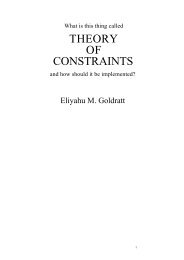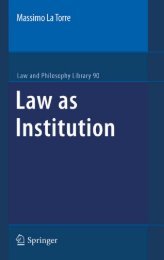Making of a German Constitution : a Slow Revolution
Making of a German Constitution : a Slow Revolution
Making of a German Constitution : a Slow Revolution
You also want an ePaper? Increase the reach of your titles
YUMPU automatically turns print PDFs into web optimized ePapers that Google loves.
64 • The <strong>Making</strong> <strong>of</strong> a <strong>German</strong> <strong>Constitution</strong>Savigny was born, was an expanding economic centre and home to a wealthy class<strong>of</strong> international merchants.Whereas educational, cultural and social demands in Prussia and Austria continuedto be eclipsed by the drive for Machtstaat, conditions on the ground werevery different in the small Rhenish principalities. 41 Here, I would argue, traditions<strong>of</strong> municipal jurisdiction continued, and the intimate scale <strong>of</strong> government demandedattention to local needs. On the eve <strong>of</strong> revolution in France, as Tim Blanning writes,it was already a region with princes promoting economic advancement as well associal reforms. 42 Policies <strong>of</strong> secularization decreased ecclesiastical influence even inthe Catholic regions. Ecclesiastical property was diverted to endow new universities,and the progressive educational climate was evident in the scientific curricula. Reformextended to primary and secondary schools as well. 43 Social reforms producedorphanages, geriatric homes, asylums and a more humane criminal system. 44 A growingcivic consciousness sustained a sense <strong>of</strong> progressive activism, leading to the rise<strong>of</strong> reading clubs, Masonic lodges and other private associations promoting reform. 45Rhinelanders continued to be active in the local law (Gemeinde- und Stadt recht) <strong>of</strong>their communities in this period. Territorial law (Landrecht) and the Roman lawbasedius commune (gemeines Recht) had effect only on a subsidiary basis. Thesewere laws <strong>of</strong> last resort in cases where there were no provisions in the urban or townlaws. The tradition <strong>of</strong> municipal jurisdiction, therefore, remained intact. As Blanningalso points out, the resolution <strong>of</strong> disputes hinged on the interpretation <strong>of</strong> autonomousmunicipal charters and customs. 46 As changing economic and social conditions raisednew legal questions, particularly relative to inheritance, marital property and privateproperty rights, lower magistrates were able to make adjustments. As farm womenin Neckarhausen increasingly produced cash crops and contributed greater wealthto the family purse, David Sabean shows that local courts ‘shifted the way they relatedto the family’, increasingly, ‘allying with whichever spouse seemed to be themost effective commodity producer’. 47 While some aspects <strong>of</strong> the societal stressesthat produced the French <strong>Revolution</strong> in 1789 were also present in Central Europe,a crucial difference between France and the <strong>German</strong> lands, as David Blackbournwrites, was the fact that <strong>German</strong> peasants had greater access to legal remedies. 48 In amanner that was tangible to ordinary <strong>German</strong>s, local measures and judicial practicemay have <strong>of</strong>fered a greater feeling <strong>of</strong> participation than existed in France. This, alongwith the duality <strong>of</strong> law tradition, meant that there were viable alternatives to violencein the <strong>German</strong> states, and this may <strong>of</strong>fer a better explanation as to why <strong>German</strong>ydidn’t erupt in violent revolution rather than any notion <strong>of</strong> bourgeois failure.In addition to the tradition <strong>of</strong> municipal jurisdiction, with the Rhenish provincesto the west and Hanau to its east, Frankfurt was in the centre <strong>of</strong> a Huguenot communityrich in the monarchomach constitutional and resistance theory that grew upduring the religious wars. Johannes Althusius, Clemens Timpler and Johann HeinrichAlsted, as discussed in the last chapter, developed a strong <strong>German</strong> monarchomachtheory in the seventeenth century that emphasized the legitimate consent <strong>of</strong> the




